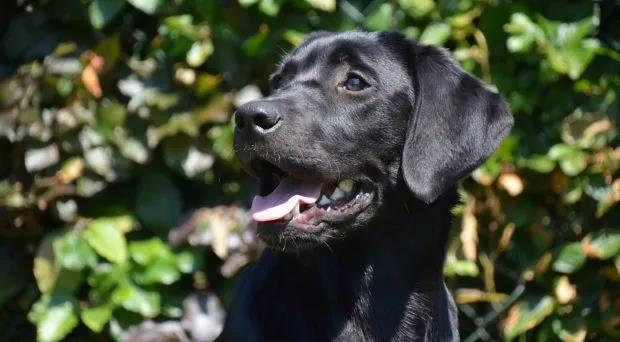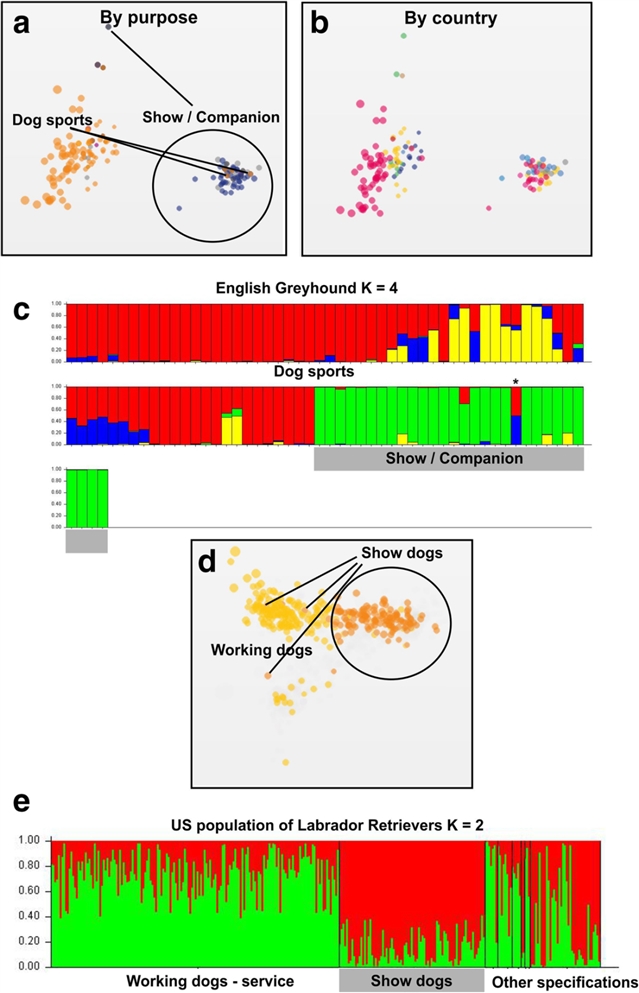|
|
| 你钟爱哪一种狗?藏在犬种基因中的秘密 | Canine Medicine and Genetics |
|
论文标题:Variation in breeding practices and geographic isolation drive subpopulation differentiation, contributing to the loss of genetic diversity within dog breed lineages
期刊:Canine Medicine and Genetics
作者:Sara Lampi, Jonas Donner et al.
发表时间:2020/06/09
DOI:10.1186/s40575-020-00085-9
微信链接:点击此处阅读微信文章
近期发表在Canine Medicine and Genetics上的一项检测犬种遗传多样性的新研究鼓励养犬人开始考虑让犬类进行跨国配种。该研究的通讯作者Jaakko Pohjoismäki将带领我们了解育种实践的新分析。

我们在Canine Medicine and Genetics上,发表了名为“不同育种方法和地理隔离会导致犬种分化出亚种,进而损害犬种遗传多样性”的研究。进行该研究时,我们购买并分析了六个犬种的基因组数据,以研究它们的亚种分化情况。这六个犬种分别是比利时牧羊犬,英格兰格力犬,芬兰拉普猎犬,意大利格力犬,拉布拉多猎犬和谢德兰牧羊犬。
我们发现这六个犬种都存在明显的亚种分化现象,要么是地理起源或专门的品种谱系内的品种。尽管我们希望看到一些分化,尤其是某些国家的犬种受到了奠基者效应的影响。但亚种间的遗传差异之大,某些犬种遗传分化的速度之快,还是令人惊讶。例如,芬兰拉普猎犬中,所谓的牧羊犬谱系,是在没有任何地域隔离的情况下,仅用30年时间,从伴侣犬谱系中分化而来的。这两者的差异仅仅是对饲养场所的偏好不同。

比利时牧羊犬和芬兰拉普猎犬的血统差异
© Pohjoismäki et al.
我们的研究结果对犬类育种实践具有现实上和哲学上的双重意义。繁育特定犬种,顾名思义,将减少不需要的变种,同时为所有的家畜驯养打下基础。通常来说,品种的分化并非总是坏事,但默认情况下,由于许多品种的数量小,容易在数代的近亲交配后发生近亲衰退。犬繁育机构无需主动消除特定血统的犬种,只需更积极地让不同血统或者血统相近的犬进行杂交。与此同时,保留特定血统依然可能是合理的,比如工作犬,品种的大多数表型分化只服务于我们的愿望,以创造专业。此外,诸如毛发颜色或外形的许多特征都是单基因决定的隐形性状。借助基因检测,可以有计划地实施杂合体杂交,从而得到这些隐形性状。需要记住的是,繁育犬种的标准是由人类制定的,所以在制定标准时,需要严格评估,考虑品种的多样性,而不拘泥于狭隘的个人理想。
这种标准具体、定义严格的育种方式被人们广泛接受,但也有一些犬种不使用这种方式育种。例如北欧斯皮茨犬,又叫诺波丹狐狸犬。该犬种的育种方式试图模仿野犬的自然选择,可以看作是育种方式的范式转换。在芬兰,繁育这种小型猎犬时,会严格限制近亲杂交,每只雄性种犬只能配种繁育30只幼犬,有公开的良种犬登记簿,对参加犬展的工作猎犬的外形、规格都有严格要求,同时强制要求种犬进行健康检查。过去一度濒临灭绝的北欧斯皮茨犬,如今已经是世界上遗传多样性最丰富的犬种之一。
我们的研究还可以作为范例,用以说明如何有效利用购买的基因组数据,为犬种的亚种分化和遗传多样性研究提供有价值的信息。通过这些数据,我们得以了解当代犬种的亲缘关系和祖先基因流,这些过去只是由养狗爱好者推测得出的信息。

英格兰格力犬和拉布拉多猎犬的谱系功能分化
© Pohjoismäki et al.
从更普遍的角度来看,种群瓶颈和选择对遗传分化的联合作用是惊人的。大多数犬种开始显示出表型多样性主要是近200年里的事,尽管这一事实众所周知,但这一事实可能仍然是一个未被重视的演化力量的作用的例子。了解犬种的遗传分化或许可以为自然种群的进化问题提供有趣的见解,例如物种的适应性辐射,或是偏远岛屿栖息地上少数创生个体的物种形成。同样地,犬类亚种的快速分化也造成了遗传多样性的减少,并凸显了栖息地丧失和破碎化对濒危物种种群遗传的影响。繁育个体较少的犬类亚种和许多种群分散的濒危物种的情况相似。因此,犬类还可提供实用、可控的模型,用以研究针对濒危物种的遗传拯救计划的效果。同时这些模型也有助于制定方案,以控制转移个体的数量和所需的遗传差异,进而达到遗传拯救的预期目标。
定向育种是一种有力的工具,几千年来人们都在使用这一工具塑造各种动物与植物。然而,随着这种力量而来的,还有不伤害他人的责任。犬类作为人类最重要的动物伙伴,值得我们用更宽阔的视野去看待。
摘要:
Background
Discrete breed ideals are not restricted to delimiting dog breeds from another, but also are key drivers of subpopulation differentiation. As genetic differentiation due to population fragmentation results in increased rates of inbreeding and loss of genetic diversity, detecting and alleviating the reasons of population fragmentation can provide effective tools for the maintenance of healthy dog breeds.
Results
Using a genome-wide SNP array, we detected genetic differentiation to subpopulations in six breeds, Belgian Shepherd, English Greyhound, Finnish Lapphund, Italian Greyhound, Labrador Retriever and Shetland Sheepdog, either due to geographical isolation or as a result of differential breeding strategies. The subpopulation differentiation was strongest in show dog lineages.
Conclusions
Besides geographical differentiation caused by founder effect and lack of gene flow, selection on champion looks or restricted pedigrees is a strong driver of population fragmentation. Artificial barriers for gene flow between the different subpopulations should be recognized, their necessity evaluated critically and perhaps abolished in order to maintain genetic diversity within a breed. Subpopulation differentiation might also result in false positive signals in genome-wide association studies of different traits.
Lay summary
Purebred dogs are, by definition, reproductively isolated from other breeds. However, similar isolation can also occur within a breed due to conflicting breeder ideals and geographic distances between the dog populations. We show here that both of these examples can contribute to breed division, with subsequent loss of genetic variation in the resulting breed lineages. Breeders should avoid creating unnecessary boundaries between breed lineages and facilitate the exchange of dogs between countries.
(来源:科学网)
特别声明:本文转载仅仅是出于传播信息的需要,并不意味着代表本网站观点或证实其内容的真实性;如其他媒体、网站或个人从本网站转载使用,须保留本网站注明的“来源”,并自负版权等法律责任;作者如果不希望被转载或者联系转载稿费等事宜,请与我们接洽。